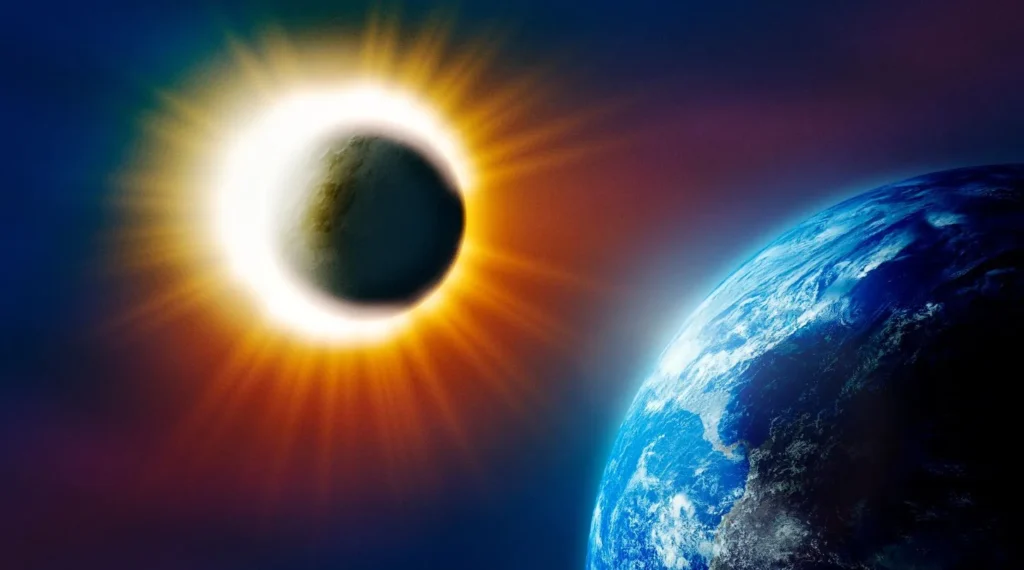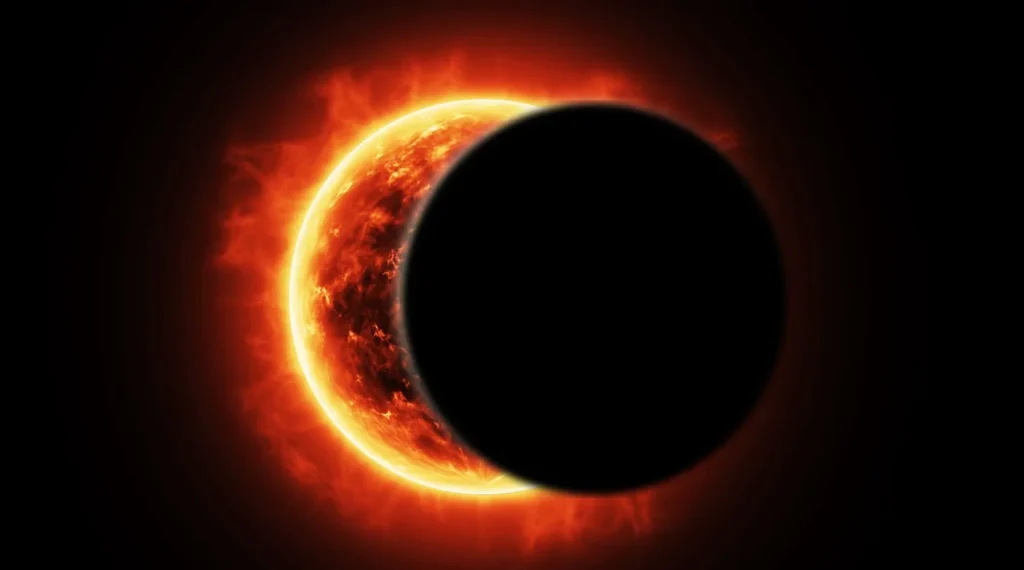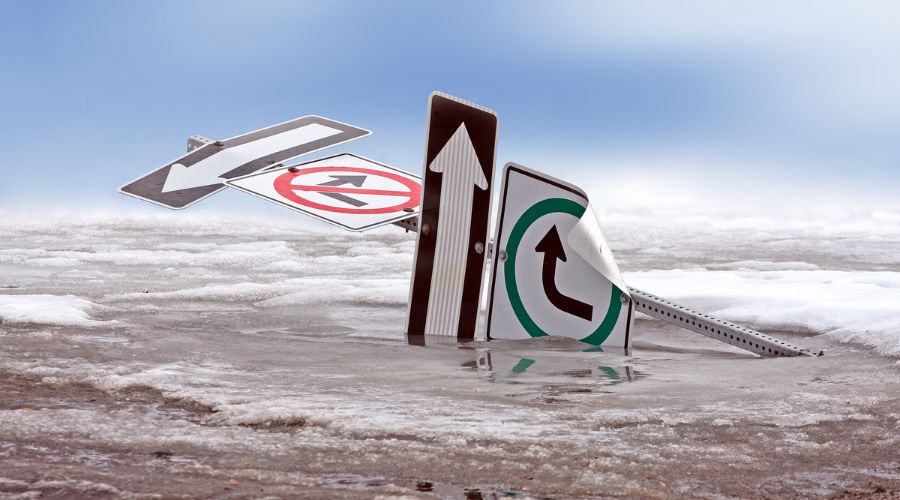Are you going to see a solar eclipse? Find out more about the many kinds of eclipses, as well as how to organize a trip to see one, how to safely observe one, and the answers to some of our most commonly asked concerns regarding seeing an eclipse.
Table of contents
What Are The Different Types Of Solar Eclipses?
Different types of solar eclipses are:
Partial Solar Eclipse
When the moon obscures a portion of the sun’s brilliant face, a partial solar eclipse happens. A partial eclipse will be seen by many spectators in the Continental United States, while others may witness a total eclipse.
During a partial eclipse, it is never safe to look directly at the sun without wearing a solar filter.
Complete Eclipse of the Sun
When the moon entirely obscures the sun’s brilliant face, a phenomenon known as the total solar eclipse takes place, briefly turning day into darkness. Viewers in the mainland United States will see a partial eclipse if they are outside the path of totality.

The only kind of solar eclipse in which people can take off their solar filters—which are not the same as conventional sunglasses—for the brief instant during which the moon completely hides the sun is a total solar eclipse.
Except during the total phase of a solar eclipse, which lasts 2-4 minutes depending on your location in the viewing path, staring straight at the sun is dangerous. Discover which parks are in the line of totality as this will only occur in specific locations.
Solar Eclipse, Annular
An annular solar eclipse happens when the moon moves in front of the sun. When the moon’s disk partially obscures the sun, an annulus—a ring of intense sunlight—is seen. When this kind of eclipse reaches its greatest phase, the moon’s “Ring of Fire” is visible. Find out which parks will get a view of the approaching annular eclipse.
Without specialized solar filters, it is never safe to stare at the sun during an annular eclipse.
Does Preparation Help?
If a park happens to be in the line of an impending eclipse, they are prepared for an increase in visitors. Get ready for the eclipse through:
Planning your trip: Make sure you’re ready for your park visit by using the Trip Planning Guide. For further details about scheduled eclipse events, as well as travel-related information including updates to park operating hours and the availability of amenities like food, water, and restrooms, visit the park website.
Carry your sun filter: Certain parks might not provide guests with safe eclipse viewing equipment. Think about packing enough sun filters or eyewear for everyone in your group. Check that your sun filters are of high quality by reading our section on eye safety.
Allow more time for your journey: Heavy traffic to the park is probably coming. Allow additional time for your journey to the park and parking, as space will be limited. Parks could change how traffic moves through them and might only have a few spots available for parking during the eclipse. Before you visit, check the park’s event page for travel information.
How Do I View An Eclipse Safely?
Using specialized solar filters, such as eclipse glasses or portable solar viewers, is the only safe way to observe the sun directly during an eclipse.
Recall that the two to four minutes of complete eclipse are the only times when it is safe to view the sun without sunglasses. Whether you are witnessing a partial or annular eclipse, or any other phase of the eclipse, it is never safe to stare at the sun without solar filters.
It’s not safe to stare at the sun while wearing regular sunglasses or homemade filters, even the really dark ones.
The ideal solar filters should include:
- Certification for ISO 12312-2:2015
- Somewhere on the goods is put the name and address of the maker.
Use of sun filters that are:
- Information on ISO certification is missing
- Lenses that are ripped, damaged, or wrinkled
- slipping out of their frames
- Manufactured prior to 2015
How to Use Eclipse Filters Properly
The solar filter comes with instructions that you should read and abide by. Kids using sun filters should always be watched over. During the eclipse, observe the sun by following these general guidelines:
- Before using, check your solar filter; if it is broken or scratched, get a new one. Read our section on seeing an eclipse without a solar filter if one is not available.
- Put on your eclipse glasses or raise your portable solar viewer to your eyes before staring at the sun.
- Turn away from the sun after looking at it through your solar filter before taking it off. Avoid taking off your solar filter when facing the sun.
- If you are in the path of totality, you should only take off your solar filter when the moon entirely obscures the sun’s face and the light abruptly becomes very dim. Reapply your solar viewer to take a quick peek at the remaining partial phases as soon as the brilliant sun starts to emerge.
This publication does not provide advise on medicine. If readers have any questions, they should speak with a licensed eye care specialist.
Observing Eclipses Using Optical Equipment
It is not recommended to use unfiltered cameras, telescopes, binoculars, or any other optical instrument to see the sun when it is partially or completely eclipsed. Similarly, when using your eclipse glasses or hand-held solar viewer, avoid looking at the sun via a camera, telescope, binoculars, or any other optical equipment. The concentrated solar rays will break the filter and penetrate your eye or eyes, perhaps leading to significant harm.
Observing Eclipses Without Solar Filters
Pin-hole projection offers a safe substitute for seeing the sun’s partial eclipse. As an illustration:
Place one hand’s outstretched, slightly open fingers over the other hand’s similarly extended, slightly open fingers. Look at the shadow of your hands on the ground with your back to the sun. During the partial phases of the eclipse, the tiny gaps between your fingers will project a grid of tiny pictures onto the ground, depicting the sun as a crescent.
Additionally, NASA provides instructions on how to build a pinhole projector.
Also Read
How to Start a Business in Washington State?
How to Start a Profitable Watch Business From Home?
How to Start a Virtual Mailbox Business?
How to Start Roadside Assistance Business?
How to Sell a Business in Texas?
How to Start a Mobile EV Charging Business?
How to Start a Mailbox Rental Business?


